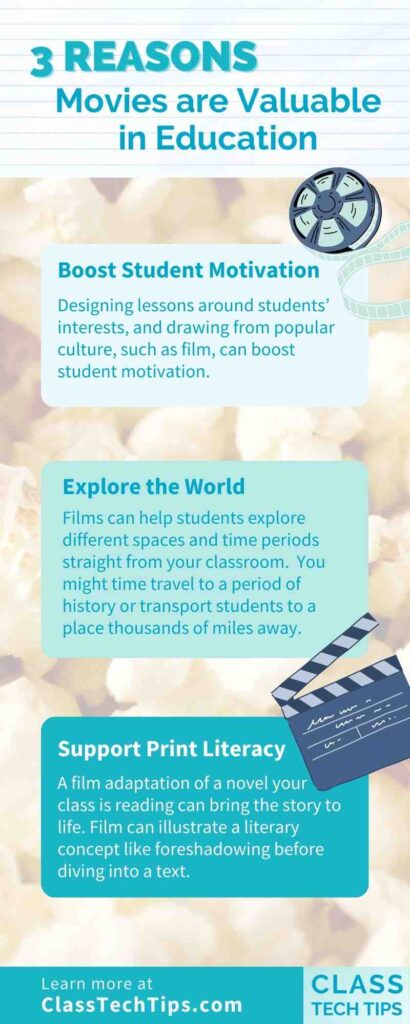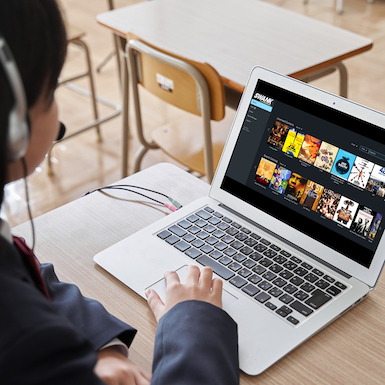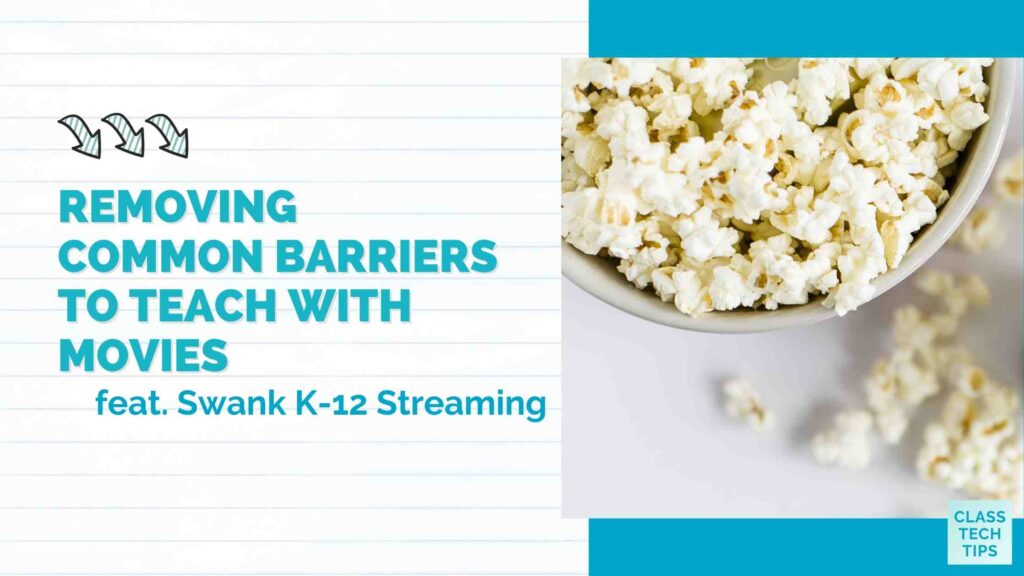Do you want to teach with movies in your classroom? Streaming a favorite movie on your home’s television might feel easier than ever. But now that we’ve moved away from video tapes and VCRs, it’s not always clear what you’re actually allowed to stream in your classroom. Movies are such a powerful tool for helping students explore a concept. I’m excited to share a way for you to stream movies in your classroom that removes the barriers to accessing and easily assigning films.
If you’ve stopped by the blog in the past, you might remember this post from last spring. I shared Swank K-12 Streaming, a platform that gives teachers access to movies they can use to support their curriculum.
Today on the blog, we’ll look at why movies play such an essential role in helping students understand new concepts. We’ll also explore how to remove the barriers to play movies in school.

3 Reasons Movies Are Valuable in Education
Joseph Goldberg, Ph.D., is a National-Board certified secondary English teacher who has conducted doctoral research centered on film pedagogy in the English Language Arts classroom. I had the chance to hear Dr. Goldberg’s perspective on teaching with movies, and he created a free guide for educators all about this topic.
There are many reasons why movies are valuable in education, from supporting literacy instruction by bringing texts to life to helping students understand what life was like during different periods of history. Here are just a few reasons why you want to use movies in your curriculum.
Boost Student Motivation
What are your students interested and excited to learn about? Designing lessons around students’ interests, and drawing from popular culture, such as film, can boost student motivation. Using movies can make curriculum and course content more relevant, too. This increases student interest, and impacts their confidence as they interact with learning material. Student engagement is a topic Dr. Goldberg explores in his guide, citing lots of research to support a connection between student motivation and teaching with movies.
Explore the World
Films provide a window into the different corners of the world that might be out of the realm of possibility for a field trip during the school year. You might time travel to a period of history or transport students to a country or continent thousands of miles away. In my book, EdTech Essentials, I list explore as one of the top 10 technology strategies for all learning environments. Films can help students explore different spaces and time periods straight from your classroom.
Support Print & Media Literacy
In this special guide created by Dr. Goldberg, he describes how “the concepts and skills teachers strive for their students to learn in literature are more visible and accessible to students in film.” You might decide to show a film adaptation of a novel to your class. This experience can bring the story to life. Or you might choose to watch a movie together to illustrate a literary concept like foreshadowing. Then students can dive into a text with those same features. In addition to supporting print literacy, teaching with movies can also support media literacy. Media literacy is increasingly important as we prepare our students for today’s world.

Barriers to Play Movies in School (and How to Remove Them)
Like so many educators, I believe that films can take a moment in history, a big science concept, or a popular piece of literature and bring it to life for students. Swank K-12 Streaming provides access to more than 30,000 movies and documentaries for academic use. They have an easy, safe, and legal streaming platform. With this powerful platform, teachers can show movies in the classroom or assign so students can watch as homework.
There is so much value in having access to high-quality materials that you can easily get in the hands of students. Swank K-12 Streaming gives teachers flexibility to teach with movies in their classroom along with the ability to assign access outside the classroom. Students can watch a movie for a homework assignment that connects a film to the content they are learning inside the classroom. Or a teacher can provide students with ongoing access to international language films to help learn a new language faster. From flipped classroom initiatives to hybrid learning environments, teachers can use Swank K-12 Streaming for quick and easy access to relevant, high-quality learning materials.
Embracing the power of film can transform how you connect students with content, however, some barriers can get in the way. A platform like Swank K-12 Streaming can help overcome these barriers to make it easier than ever to teach with movies.
Blocked personal streaming sites in the classroom
Using a popular streaming platform that you have access to at home might seem like a quick fix for getting a movie into your classroom. But, many districts block access to personal streaming accounts or have policies against their use. This is due to a number of reasons, including legal concerns and the need to determine if content is truly appropriate for a group of students or not.
DVD equipment is a hassle
In the past, using a VCR or DVD player was the popular option for sharing a feature film. However, locating a player and DVD or video tape are barriers that you shouldn’t have to tackle anymore. Not only is it difficult to keep track of equipment and share it across classrooms, but if a student is absent from class they won’t have access to the movie the rest of the class watched together.

Administrators have little oversight
Whether it is DVDs or personal streaming or another access point, school or district administrators are often in the dark about what movies are being shown in classrooms and when. Many districts have policies built around the use of movies — with no ability to monitor usage or offer support to their teachers. Within Swank K-12 Streaming, administrators have visibility into what movies are being shown when, as well as what movies teachers have available to them in the library as a whole. They can make recommendations to teachers and give them easy access to high-quality learning materials.
How to Play Movies in Your Classroom
How can you solve this problem and address the barriers to play movies in your classroom? Swank K-12 Streaming gives teachers, schools, and districts easy access to feature films for education. You can start with their curated collection of movies, and submit custom title requests if there is something specific you’re looking to stream. There are over 30,000 movies and documentaries to share with your students, including many movies that educators are already using in their lesson plans.
Ready to try out Swank K-12 Streaming in your school? Use this link to register for a free webinar happening on April 17th. If you can’t make it to the live event, you can still sign up. After the event, they will send you a link to the replay so you can watch it at a time that works for you. And if you want to learn about Swank K-12 Streaming right now, use this link to head straight to their website. I can’t wait to hear what you think about all of the resources they have to offer!







